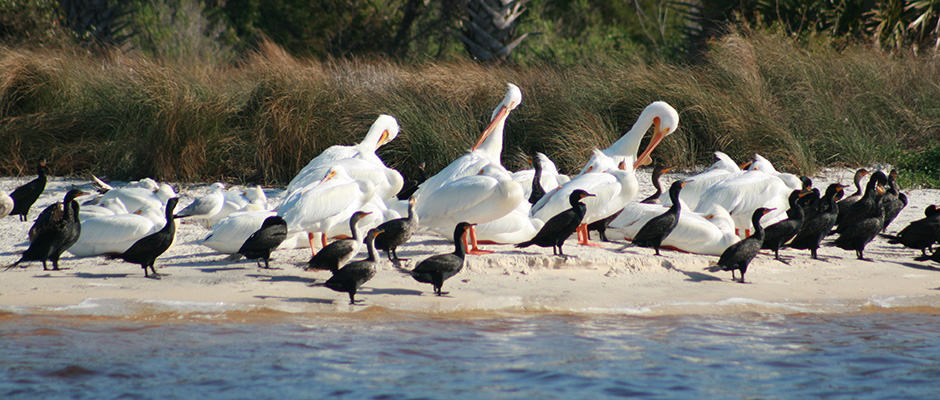Share this article
Birds Vanish Mysteriously from Florida’s Seahorse Key
In the blink of an eye, an island on Florida’s Gulf Coast that was once filled with the chattering of the largest long-standing colony of seabirds and water birds on the coast, Seahorse Key, became silent and barren, left with only broken egg shells scattered on the ground and abandoned nests in trees.
The island — a 150-acre mangrove-covered dune and a part of the Cedar Keys National Wildlife Refuge — was home to a colony of herons, egrets, ibises, pelicans, cormorants, and others for 30 to 40 years, according to Peter Frederick, a research professor with the Department of Wildlife Ecology and Conservation at the University of Florida, a partner with the national refuge system. But in mid-April this year, the birds were gone.
“Typically, we have checks on the colony about three or four times during nesting season,” Frederick said. “The colony began nesting in late February and early March, and by mid-April, it was abandoned. And when I say that, I mean completely abandoned. There were no birds at all.”
Individuals with the refuge complete annual surveys where they count the birds in order to develop an index of the population. However, this disturbing disappearance was detected by an individual at the marine lab in Seahorse Key who showed up one morning and noticed there were simply no birds left, according to Larry Woodward, the deputy manager of the Lower Suwannee and Cedar Keys National Wildlife Refuges. “I was out there a couple of days before the event and the birds were doing fine,” Woodward said.
About a week after the discovery, Frederick and Vic Doig, the wildlife biologist for the refuge system, hopped on a boat to Seahorse Key, which is about four to five miles off shore, and surveyed the island to find out what drew the birds away. They found bird carcasses, abandoned nests and broken egg shells, and determined that it had been about one and half weeks since the abandonment occurred. Frederick said the broken egg shells were likely from egg predators such as common fish crows (Corvus ossifragus) that knock them to the ground. Doig and Frederick sent the carcasses out to the lab and were able to rule out disease as the reason for their abandonment.
While Frederick said they don’t know why this abandonment occurred, they were able to rule out most natural causes. “We do not believe that there was an interruption in food supply,” Frederick said.
Frederick and others also noticed that after the site was abandoned, about a quarter of the birds began nesting in Snake Key, which is about 1.5 miles from Seahorse Key. While only some of the birds moved to nest in Snake Key, it’s a good representation of all of the species that were at Seahorse Key, according to Woodward. “This justifies the importance of protecting the surrounding areas as a reserve in these cases,” he said.
In recent years, a small number of birds have begun nesting in Snake Key because the mangrove area has been expanding, Frederickson said. And in the 1940s and 50s, there had been evidence of the birds switching from Snake Key to Seahorse Key due to predators and vegetation changes. However, this time, this doesn’t seem to be the case. “There have been predators like raccoons at times over the last decade, but there have not been more than one or two on the island,” Frederick said, adding that while there was one raccoon on the island at the time, it was unlikely that was the reason for the abandonment. “Raccoons typically bite and crush eggs, and we saw no crushing of eggs on the island,” he said. Frederick said predators such as bald eagles have also been ruled out since there are also bald eagles on Snake key where some of the birds relocated.
Since researchers have ruled out natural disturbances, they are now looking into human-related causes. “Predation is not likely, food interruptions are not likely. What we are left with are some unknown catastrophic disturbances,” Frederick said. “This could have been related to human activities.” Woodward added, “I feel strongly that there was some sort of human impact.”
These possible disturbances could range from someone shooting onto the island to helicopters flying by during the night time. However, aircraft overflights are generally not disturbing to nesting birds, according to Frederick. “It depends on the altitude, noise, duration and type,” he said. “If birds are abandoning in response to aircrafts, it has to be severe.” Law enforcement is currently looking into these possibilities.
Meanwhile, Frederick and Woodward feel lucky that Snake Key was nearby as a refuge for some of the birds. “It’s a darn good thing we had Snake Key for the birds to go to,” Frederick said. “It’s one of the functions of the national wildlife system to provide those safety valves.”
Woodward hopes the birds come back from Snake Key next year and that Seahorse Key’s site fidelity for nesting birds isn’t lost. “We’re hoping we can find out what could create such a catastrophic event where the whole colony is abandoned,” Woodward said. “It is unprecedented with that number of species of birds leaving all at once. My big concern is what happens next year.”
Header Image:
White pelicans (Pelecanus) in Seahorse Key on Florida’s Gulf Coast. In mid-April, a long-standing colony of seabirds and water birds abandoned their nests at Seahorse Key leaving biologists baffled.
Image Credit: Justin Warner via Flickr








